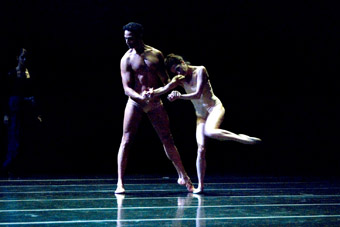lost in translation
martin del amo sees nacho duato’s take on wings of desire

Alas, Compania Nacional de Danza
photo Prudence Upton
Alas, Compania Nacional de Danza
ALAS (WINGS) TAKES ITS INSPIRATION FROM WIM WENDERS’ 1987 FILM WINGS OF DESIRE IN WHICH TWO ANGELS ROAM BERLIN, UNSEEN AND UNHEARD, LISTENING TO THE THOUGHTS OF THE CITY’S PEOPLE. TIRED OF AN EXISTENCE OF ONLY EVER OBSERVING RATHER THAN EXPERIENCING, ONE OF THE ANGELS, DAMIEL, DECIDES TO GIVE UP HIS IMMORTALITY AND BECOME HUMAN IN ORDER TO BE ABLE TO SENSE, PHYSICALLY INTERACT AND LOVE. ALAS IS THE MOST RECENT CREATION BY SPAIN’S COMPANIA NACIONAL DE DANZA AND MARKS THE FIRST-TIME COLLABORATION BETWEEN THE COMPANY’S ARTISTIC DIRECTOR, NACHO DUATO, AND THE SLOVENIAN THEATRE DIRECTOR TOMAZ PANDUR.
Duato is widely regarded as one of the most important ballet choreographers of the last 20 years. His ensemble, whom he has lead since 1990, has an excellent international reputation and frequently tours outside of Spain. Not surprisingly then, the dancing in Alas is exquisite. On a stage dominated by a cross-tiered, tower-like structure that is evocatively lit from within, 16 extraordinary dancers glide, slide and float. Their technique is immaculate, their precision awe-inspiring and yet their personalities always shimmer through. They are powerful and athletic, excelling at dashing across the stage at breakneck speed. They are equally impressive in the lyrical sections, performing intricate gravity-defying duets. Duato himself dances the role of Damiel. Recently turned 51, his maturity and commanding stage presence are compelling.
Alas is an exceedingly beautiful production with lavish costumes, masterful lighting and many moments of choreographic magic. And still, as a work it is not entirely convincing, somewhat disappointing even. This is due, ironically, to Alas being based on Wenders’ famous film.
Translating a work of art from one medium to another always risks pitfalls. It would be unfair to criticise an adapted work along the lines of the-book-was-better cliché. It is valid though, in this case, to point out that the ongoing success of Wenders’ film is partly due to its striking originality both in terms of content and form as well as its conceptual audacity. It was a masterstroke by Wenders and his co-author, Austrian writer Peter Handke, to parallel the dilemma of human existence with the fate of an angel whose desire it is to be freed of his immortality so he can immerse himself in a world that causes so much anxiety and pain to those who inhabit it. This delicious variation on “the grass is always greener on the other side” is as fantastical as it is poignant.
In Alas, however, the quiet poetry of the film is replaced with pathos and grand gesturing. The beauty it so successfully conjures is not undercut by the bleakness and the laconic theme of hope in the face of adversity so evident in the film. Alas, in fact, comes across as a blatant, almost hedonistic celebration of beauty alone and ultimately has a hollow ring to it. It still makes for a spectacular dance experience but without the brilliance and vision of the film to which it aspires.
Compania Nacional de Danza, Alas, choreographer Nacho Duato, theatre director Tomaz Pandur, costumes Angelina Atlagic, lighting Brad Fields, texts Wim Wenders, Peter Handke, Lyric Theatre, Sydney, Jan 11-13
RealTime issue #83 Feb-March 2008 pg. 15






